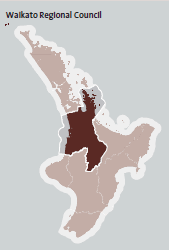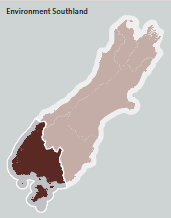Appendix 1: Regional council summaries
Managing freshwater quality: Challenges for regional councils.
| Waikato Regional Council (WRC) | |
| Map of region |  |
|---|---|
| Regional features | Population: 382,716 Urban/rural: 75%/25% Land use: 58% pastoral farming/ 1% urban Regional council staff: 365 Number of dairy farms: 4200 Geographical features:
|
| Overall findings | Freshwater quality is not maintained or enhanced in the Waikato region. The current package of regulatory and non-regulatory methods and how they are implemented is not sufficient to manage threats to freshwater quality. WRC is beginning to take steps to address the notable challenges in managing non-point source pollution in its region. Its regional plan review provides an opportunity to improve its planning framework and better target programmes to manage the main risks to freshwater quality in the region. |
| Recommendations | We recommend that WRC:
|
| Water quality state and trends | Freshwater quality in the Waikato region mostly fails to meet WRC's standards and accepted trigger values. Trends also indicate that there is cause for concern over deteriorating conditions, which far outweigh results that show some signs of improvement. |
| Reporting to the community | WRC has effective systems to report freshwater quality information to the Council and community. There is some room to improve how information is reported to the community – for example, by providing clearer links between the results and the causes of any declining conditions. |
| Making a timely response to freshwater quality issues | WRC's monitoring systems identify risks to freshwater quality in the region and inform policy and planning analysis. WRC has changed its plans and policies over time to improve how it manages freshwater quality. These changes align to some of the known risks in the region. We cannot provide assurance that WRC's operational response systems address potential and known risks to freshwater quality in a timely or effective manner. WRC needs to improve its performance measures and targets for responding to complaints and pollution incidents. |
| Effectiveness of regulatory and non-regulatory programmes | WRC's regulatory and non-regulatory methods target the known risks to freshwater quality from land use, but there is no evidence that these provisions have been effective in maintaining or enhancing freshwater quality in the region. Given the rates of non-compliance and the state of freshwater quality, it may be time for WRC to consider more stringent regulatory methods. |
| Compliance monitoring and enforcement action | WRC does not appear to currently have effective strategies or management systems to address risks associated with significant non-compliance and/or repeat non-compliance. Analysis of WRC's enforcement trends shows high rates of formal warnings versus formal enforcement action. We question whether WRC's enforcement strategies are consistent and strong enough to be effective in changing non-compliance in the region. |
| Taranaki Regional Council (TRC) | |
| Map of region |  |
| Regional features | Population: 104,124 Urban/rural: 77%/23% Land use: 60% pastoral farming Regional council staff: 122 Number of dairy farms: 1848 Geographical features:
|
| Overall findings | Freshwater quality is generally being maintained and, in places, may also be improving. However, there are areas where surface water quality does not meet relevant trigger values and areas where trends are deteriorating. In these low-elevation areas, this may indicate that current management tools are not enough to improve water quality, and the deteriorating trends may indicate potential for further decline. |
| Recommendations | Given that TRC is so well positioned, it could be more ambitious with taking action to enhance freshwater quality in those low-elevation areas where it does not meet relevant trigger values. There is a risk that non-regulatory riparian management programmes will not deliver the results anticipated because of slow implementation of riparian plans. Options to mitigate this risk could include:
|
| Water quality state and trends | Overall, surface water quality in Taranaki does not meet relevant trigger values for five variables in low-elevation areas. It meets the trigger values for the other three. Trend data mostly show no significant change, but there are deteriorating trends in ammoniacal nitrogen and water clarity. These indicate that surface water quality may be at risk of deteriorating in low-elevation areas. Other areas mostly have better surface water quality. |
| Reporting to the community | State of the Environment freshwater quality information was generally well communicated and is improving. However, there is potential for improvement: TRC could explain more clearly what the implications of water quality are for the user. It could better connect the freshwater quality indicator information to outcomes, such as algal blooms or the water being unsafe for drinking. |
| Making a timely response to freshwater quality issues | From the evidence we have seen, TRC has effective systems to identify risks to freshwater quality. It has policies, procedures, protocols, and systems to respond to known risks to freshwater quality in a timely manner. TRC has a strong focus on fine-tuning and improving implementation of the policies and methods it has chosen. |
| Effectiveness of regulatory and non-regulatory programmes | TRC has a well-developed framework for preparing plans, implementing them, and reviewing the effectiveness of the plans. The regulatory and non-regulatory frameworks are consistent and integrated. The overall framework uses non-regulatory methods to produce farm plans and promote riparian planting, the on-farm implementation of which has been slow. Despite this approach, we have confidence that TRC is actively managing and adapting the riparian programme to maximise its effectiveness. |
| Compliance monitoring and enforcement action | TRC has established and consistent processes for monitoring consents. It consistently takes enforcement action where necessary and reports a very high compliance rate. At the time of our audit, the dairy effluent management programme was managed efficiently but its effectiveness was dependent on visual checks on dairy effluent systems. TRC has since decided to do routine testing of effluent quality as part of its compliance monitoring. |
| Horizons Regional Council (HRC) | |
| Map of region |  |
|---|---|
| Regional features | Population: 220,089 Urban/rural: 51%/49% Land use: 61% pastoral farming Regional council staff: 200 Number of dairy farms: 900 Geographical features:
|
| Overall findings | HRC has planned a well-designed suite of regulatory and non-regulatory programmes that are appropriately targeted at reducing the known risks to freshwater quality. Emerging trends show water quality may be improving, and indicate that HRC interventions may be helping. Overall, HRC is maintaining and enhancing freshwater quality in the Whanganui and Rangitikei rivers, but not in the Manawatu River. We expect to see improvements as point source discharges and land use practices for managing contaminants are improved. HRC made a significant and positive response to the findings of our 2005 performance audit of its freshwater management. Its new policy framework and its implementation represent significant improvements since our earlier audit. |
| Recommendations | We recommend that HRC:
|
| Water quality state and trends | Water quality in the region does not meet a number of trigger values or the One Plan water quality targets. For most water quality indicators, there is no significant improvement or decline, meaning water quality is remaining steady. For some sites and indicators, this means that adverse water quality is persisting. |
| Reporting to the community | Freshwater quality information is appropriately provided to Council committees and the public. HRC last produced a State of the Environment report in 2005, and now provides up-to-date water quality information online. The information provided online could be further summarised to make the messages more accessible for the public. HRC is not currently meeting the RMA requirement to compile and make available to the public a review of its monitoring of the effectiveness and efficiency of policies, rules, or other methods in its policy statement or its plan at least every five years. |
| Making a timely response to freshwater quality issues | HRC is using the information arising from its monitoring programme to amend policy and investigate issues as they emerge. The time frames of 4 hours for responding to urgent pollution incidents and 2 days for non-urgent incidents are not always met because of staff availability. |
| Effectiveness of regulatory and non-regulatory programmes | Regulatory and non-regulatory programmes are appropriately targeted at reducing the known risks to freshwater quality in the region. Regulation for freshwater quality means that any proposed activity must ensure that targets are met. Intensive land use is regulated with specific policies to manage nutrients and dairy cows access to water bodies. Non-regulatory programmes involve HRC working closely with stakeholders to bring about improvements in water quality. |
| Compliance monitoring and enforcement action | HRC has a strong framework for implementing compliance monitoring – this includes regular dairy farm resource consent compliance inspections, and financial incentives for compliance. HRC operates robust procedures for carrying out inspections, which have resulted in it taking more enforcement action. HRC's approach to compliance is fair and consistent for resource users across the region. |
| Environment Southland (ES) | |
| Map of region |  |
|---|---|
| Regional features | Population: 91,000 Urban/rural: 70%/30% Land use: 30% pastoral farming Regional council staff: 106 Number of dairy farms: 785 Geographical features:
|
| Overall findings | The package of regulatory and non-regulatory methods and how they are implemented by ES is not enough to mitigate the known threats to freshwater quality in the region. |
| Recommendations | We recommend that ES:
|
| Water quality state and trends | Many sites in Southland are not meeting ES's published standards and some are also showing deteriorating trends. ES's freshwater quality management strategies do not appear to be preventing water quality from deteriorating. |
| Reporting to the community | ES has effective systems to report freshwater quality trend information to the council and the public. Some improvements could be made to help the public better understand the results. |
| Making a timely response to freshwater quality issues | ES has systems to identify risks to freshwater quality. However, in many instances, responses to these known risks do not appear to be timely or effective in addressing known sources of contamination. The incident follow-up system needs to be improved to ensure that risks are managed by staff. ES has taken an adaptive management approach to managing freshwater quality, evidenced by the various changes and proposed changes to the regional policy statement and Regional Water Plan. It is too early to comment on the effectiveness of these changes. |
| Effectiveness of regulatory and non-regulatory programmes | ES's planning and regulatory framework and its non-regulatory methods appear to target the areas of highest risk. However, the implementation of its regulatory framework is not currently effective in responding to known risks to freshwater quality, given the increasing rates of non-compliance and declining trends in freshwater quality. At the time of our audit, ES did not have any geographically focused regulatory methods to address the current risks to freshwater quality in the Waituna Lagoon. It is unlikely that the non-regulatory methods are sufficient to address a notable risk to this internationally recognised wetland. |
| Compliance monitoring and enforcement action | Based on the increasing rates of significant non-compliance, marginal compliance and repeat non-compliance, as well as the operational issues for compliance activities, ES's implementation of its compliance monitoring and enforcement of plans and policies is not effective in protecting freshwater quality in the region. |

